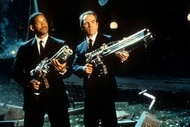What we think we know about time travel

It's strange living in a post-Back to the Future world. Not only have we surpassed the date of the future portrayed in Back to the Future Part II, we're also 30 years removed from the release of the third and final film, which premiered in theaters on May 25, 1990.
Over the course of three movies, we saw Marty McFly and Doc Brown travel throughout recent human history and the near future, going as far back as the Wild West and as far forward as the unimaginably distant 2015. The Back to the Future films are fanciful science fiction comedies, not meant to be taken seriously. The science is accurate only insofar as it serves to tell a good story.
Still, is it possible to go forward and see our mistakes before they happen? Is it possible to go back and fix things that are already in our past? Here's what we know — or think we know — about time travel.
WHAT IS TIME?
Time: the great equalizer. Time doesn't care about you at all. You can't gain more of it, and you can't give it away. Irrespective of any other thing about you, each of us lives through the same 24 hours every day. Right?
Not exactly.
Time is mushy. It's variable. Some have called it wibbly-wobbly. And it turns out, you can manipulate it if you try hard enough, thanks to Einstein.
We evolved in a sort of medium environment. Human beings are medium-sized objects, somewhere between the very small (quarks, electrons, atoms, and the like) and the very large (planets, stars, and supermassive black holes). And we operate at medium speeds, faster than the slow movements of tectonic plates, but slower than the speed of light.
Physics operates in pretty predictable ways in the world we inhabit. Gravity impacts objects in ways we can accurately measure; comets orbit and return at regular intervals. We know when solar eclipses will happen because the cosmic dance of the sun and moon follows along a known path. Time ticks onward in one direction and at a consistent rate. All is as it should be, all is according to plan.
Outside of our medium-sized world, however, things can get weird.
Physics breaks down when you get too small, or too massive. Gravity does things we can't quite work out, quantum effects find their way in. Things cease to play by the rules as we know them. Likewise, the faster we accelerate beyond our medium speed, the weirder time gets.
Special relativity concluded that the speed of light is consistent for all observers. Photons moving through a vacuum travel at a staggering 186,282 miles per second.
That speed is impressive all on its own. It's fast enough that the time delay between when light hits an object, bounces off, and enters our eyes is so short as to not be noticed. Which is good, especially for our ancient ancestors. It would have been difficult to evade predators if we were already half-swallowed by the time we noticed them.
The speed of light, though, becomes even more impressive and bizarre, because of the way it remains constant no matter the position or speed of the observer. Let's break down what that means. The actual speed of any given object is a combination of its personal speed, combined with the speed of any other objects acting upon it.
For instance, let's suppose you're reading this while sitting down. Your personal speed is zero. You aren't moving at all, relative to any objects you're in contact with. Easy enough. But maybe you're on a train on your way to work, and that train is traveling at 75 miles per hour.
Your speed then becomes the combined speed of you and the speed of the train. Let's go further. The train is traveling at 75 miles per hour relative to the Earth, but the Earth is traveling at 67,000 miles per hour around the Sun. Furthermore, the Sun is traveling at 514,000 miles per hour around the center of our galaxy.
Assuming the train, the Earth, and the Sun are all traveling in the same direction, your total speed is actually 581,075 miles per hour.
That doesn't even take into account the speed of the galaxy through space, but you get the point. To someone sitting on the train with you, our speed is zero. Your speed is different to an observer standing on the ground outside the train, it's different to someone observing from the Sun, or from the center of the galaxy. The position of the observer matters, it changes the outcome.
Speeds compound, that's the way things work in the Medium world. Not so with light.
Replace the train traveler with light and everything we expect about compounding speeds goes out the window. The apparent speed of light remains the same, 186,282 miles per second, regardless of the position or relative speed of the observer. Light gets no faster and no slower.
Special Relativity suggests an elegant, if counterintuitive, solution to this problem. As objects increase in speed, time moves more slowly. Changing the length of each tick of the clock allows the speed of light to remain consistent no matter how fast you're traveling in respect to it.
When Special Relativity was published, these ideas were just numbers on a page, but they've been confirmed by observation and experimentation. In fact, engineers have to account for time dilation when designing satellites.
Because they are orbiting at speeds much faster than we're accustomed to on the ground, a satellite's internal clocks will run more slowly. The difference is very small, but can stack up over time. Since satellites often need to have accurate timekeeping, this time dilation has to be accounted and corrected for.
It gets even more complicated because of gravity.
Gravity bends spacetime and, since GPS satellites orbit so far away from the surface of the Earth, they feel the effects of gravity less than we do, which has the opposite effect of causing the clocks to tick more quickly. All told, GPS satellites in orbit would drift 38 microseconds into the future every day if we didn't account for relativity.
It's a small amount, it would take about 72 years for their clocks to drift ahead of ours by one second, but it's enough to wreak havoc with GPS services, pretty quickly.
Besides, the synchronicity of our clocks isn't the important bit. What's important is the reality that those satellites are actually time-traveling at a rate of one second every 72 years. The effect is slow, but that's only because the fraction of the speed of light at which their traveling is small.
Time isn't static. It's personal. We aren't all experiencing the passage of time in the same way or at the same rate. Every time you get in a car, a train, or a plane, every time you go for a jog or even stagger to the bathroom in the middle of the night, you're altering the way you travel through time.
GRAVITY AND SPEED
Now that we know we can alter our relationship to time, by altering our speed or by manipulating gravity, how can we use that to our advantage and travel to distant temporal locales?
Speed is probably our best bet right now.
Considering the timescale of human existence, we've made incredible strides in increasing our maximum speed over the last several decades. It was once believed we would never break the sound barrier; that was accomplished by Chuck Yeager in 1947, a little more than 70 years ago.
That was the first time a human being traveled faster than 343 meters per second. That's about ten-thousandth of a percent of the speed of light. Pretty fast by human standards — very slow on the cosmic scale.
A little more than a decade later, Neil Armstrong, Buzz Aldrin, and Michael Collins blasted off in a rocket, headed for the Moon. Their top speed was 25,000 miles per hour, more than 32 times faster than Yeager. Still, the crew of Apollo 11 was traveling at only 6.94 miles per second, roughly 0.0037 percent of the speed of light.
Getting closer, some of those zeroes are falling off. Still, it's a long way away.
That's about where we top off, for now. At least for crewed vehicles. We have created faster spacecraft.
The Parker Solar Probe, launched in 2018, was sent on a mission to study the Sun's corona. It approached to within 18.7 million kilometers, granting it the honor of closest approach of any artificial object.
At its fastest, it was traveling 430,000 miles per hour, or, 119.4 miles per second. That gets us to 0.064 of the speed of light.
We'd have to get moving more than 15 times faster than the fastest craft we've ever built to hit one percent the speed of light.
Even at those speeds, we'd notice a difference in relative time of about 26 minutes over the course of a year.
If you really want to time-travel in a significant way, you have to get much faster.
At 90 percent of the speed of light (167,653.8 miles per second), a craft traveling for 10 years according to their own clock would arrive back on Earth to discover that nearly 23 years had passed.
At 99.99 percent of the speed of light, a craft traveling for one year would come back to a world that had aged more than 70 years in their absence.
At 99.99999 percent of the speed of light, for a year, more than 2000 years would pass on Earth.
The point is, the closer you get to the speed of light, the more time dilation is experienced.
Achieving those speeds, however, is incredibly unlikely and probably impossible. Physics conspires against us in this regard. Any object with mass increases in mass as it approaches the speed of light. In effect, it gets heavier, which requires more fuel to continue to accelerate. Eventually, you reach an infinite mass and infinite energy requirement. It's like pushing a stone up a continuously inclining hill. It gets harder the closer you get to the top.
Which is too bad, because nearing the speed of light would allow us to travel forward in time, with minimal investment of personal time. And, if we could break the light speed barrier, all bets are off. The math suggests that it might allow us to violate causality and travel back.
If speed isn't the answer, then what about gravity?
Since we know space and time are intimately tied together, and that gravity impacts both (see GPS satellites, above) sufficiently warping space-time would create closed time loops. At least according to research by theoretical physicist Amos Ori at the Technion-Israel Institute of Technology in Haifa.
Ori suggests using focused gravitational fields to bend spacetime into a donut-shaped vacuum.
There is one speed bump: A traveler would only be able to go to time-destinations that occurred after the creation of the donut. No going back to see the dinosaurs or save your mom from marrying the wrong person. No preventing things that have already happened before the creation of the machine. Additionally, the gravitational fields required are on the order of those created by black holes, far beyond what we're capable of creating or controlling.
For now, time travel is outside of our capability, at least as it's portrayed in movies. If you really want to evade the ticking of the clock, your best bet is to run as fast as you can.


























